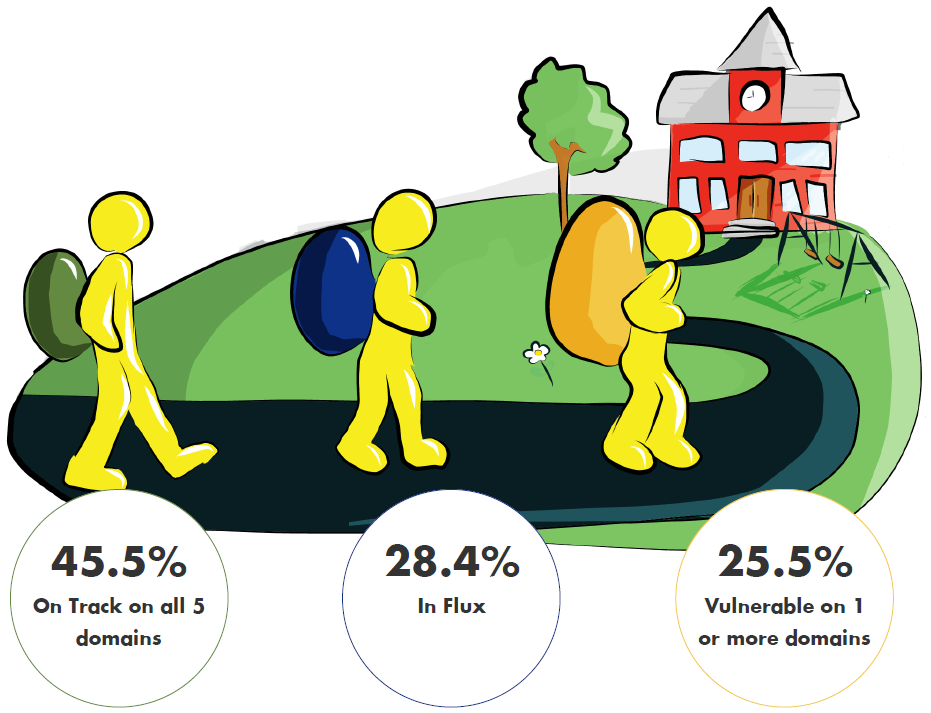Early Development Instrument (EDI)

The early childhood period is the most critical developmental phase of human beings.
One way to support early childhood development is to understand children’s developmental growth. We can measure children’s ability to meet age-appropriate developmental expectations with the Early Development Instrument (EDI).
What is the EDI?
The EDI is a Canadian-made, internationally recognized research tool developed by the Offord Centre for Child Studies at McMaster University.
It is used to measure developmental health trends and changes in populations of five-year-old children.
The EDI questionnaire is completed by Primary teachers for the children in their class.
They are filled out in February-March of the implementation year, after teachers have had the chance to get to know their students. This ensures that teachers are able to answer the questions for each student knowledgeably.
The EDI includes 104 questions and measures five important areas or domains of early child development:
![]()
Physical Health &
Well-being
child is physically
independent, has
gross & fine motor
skills & good health.
![]()
Social
Competence
child can play and
work well with other
children, willing to
try new things.
![]()
Emotional
Maturity
child can manage
feelings, consider
the feelings of
others.
![]()
Language & Cognitive Development
child can listen to
stories, interested in
books, reading and
numbers.
![]()
Communications Skills & General Knowledge
child understands communications,
can tell a story,
share experiences.
What does EDI tell us?
EDI shows patterns of child development – both across the province and within local communities.
The domains are good predictors of youth and adult health, education and social outcomes.
The EDI does not diagnose individual children nor evaluate a teacher’s or school’s performance. EDI is a starting point to inform how we introduce policies and programs to best support child development.
The EDI:
- Increases awareness of the importance of the early years;
- Identifies areas of strength and weakness in children’s development;
- Provides evidence based research to support community initiatives for healthy child development;
- Strengthens relationships between researchers and communities; and
- Provides communities with information to support future planning and service development.
What is vulnerability in the EDI?
Children scoring in lowest 10th percentile on an EDI domain are considered vulnerable.
- Vulnerable children are children who without additional support will likely experience future challenges in school and society.
- Vulnerability can’t be attributed to a single cause.
- Healthy early development is complex, influenced by many factors and is a result of accumulative experiences in the early years.
EDI in Nova Scotia
Nova Scotia has four cycles of EDI results, collected in 2013, 2015,2018 and 2020.
Lowest 10th percentile of children in the first Nova Scotia EDI in 2013 created vulnerability cut-offs. These vulnerability cut-offs were used to create the Nova Scotia Baseline to measure Nova Scotia children with Nova Scotia children over time, reflecting their reality.
At the national level, vulnerability as measured on the EDI is experienced by 28% of Canadian children (reported by the Canadian Institute for Health Information based on the most recent data available from each of the provinces and territories).
In 2020, Nova Scotia experienced a meaningful decrease in vulnerability compared to 2018 (25.5% versus 28.8%). The rate of vulnerability in 2020 is consistent with results in 2015 and 2013.
EDI Indicators, Nova Scotia 2020
Note: Children will fall into only one of these three groups, therefore total should be approximately 100%.
45.5% On Track on all 5 domains
Children with scores above the 25th percentile cut-off on all five domains. These children are considered to be developing well in all areas of development health for their age.
28.4% In Flux
These children are not vulnerable on any of the domains, however they are not on track on all five domains. This group of children falls above the 10th percentile on all 5 domains, but below the 25th percentile on at least one domain. These children may need more support or may catch up with their peers. (These children are not all in the at risk category, they may fall into the at risk category on some domains, but on track in others).
25.5% Vulnerable on 1 or more domains
Children with scores below the 10th percentile cut-off on any of the five domains. Being vulnerable means that children are at an increased risk of difficulties and, without additional support, may continue to experience challenges.
Nova Scotia Early Development Instrument (EDI) Reports
2023
- Summary Report: Primary Students in Nova Scotia, 2022-23
- EDI Over Time Report: a snapshot of children's developmental health at school entry (2013, 2015, 2018, 2020, 2023)

